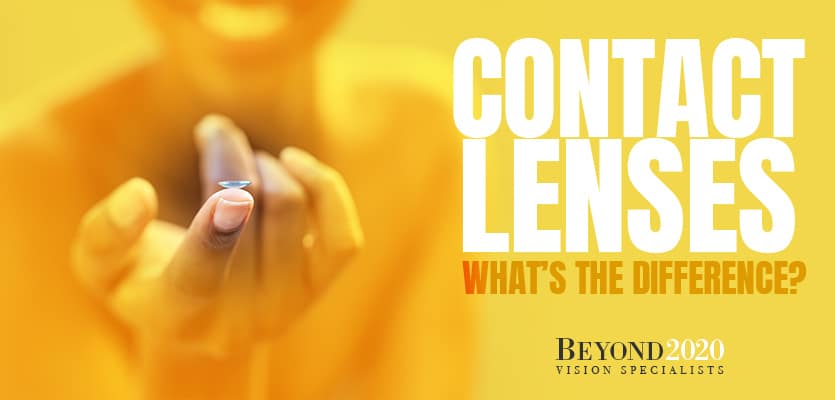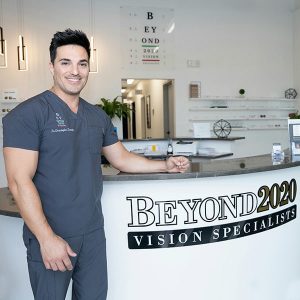Multifocal, toric, and monovision contact lenses: What's the difference?
Home » Multifocal, toric, and monovision contact lenses: What’s the difference?

Multifocal, toric, and monovision contact lenses: What's the difference?
Treating Astigmatism
A surprising number of people in the United States have astigmatism, a refractive error that creates blurry vision and difficulty seeing fine details. It happens to about a third of the population, and it may coincide with near- or farsightedness or other conditions. The unique shape of a toric lens corrects for astigmatism that occurs when the cornea’s curvature requires it.
Toric contacts need a prescription and fitting by a doctor, just as all contact lenses require. An Odessa FL optometrist at Beyond 2020 Vision Specialists, conveniently located on Highway 54 near the Suncoast Expressway, makes local treatment available.
Requiring Unique Orientation
Manufacturers produce the lenses in various styles, but they have a characteristic that makes them different from others. To fit properly and correct astigmatism issues, they must remain in a particular position in the eye. Different techniques for making them stay that way produce the effect that wearers need.
The unique capacity of toric design needs precise fitting even more than other types of lenses require. An Odessa FL optometrist can ensure they fit precisely and do not slip as they produce improved visual clarity. Everyone’s eyes have specific characteristics that make each case different. Statistics from the American Academy of Ophthalmology (AAO) show that one in three Americans have vision attributes that cause some degree of astigmatism.
Considering the Options
Toric contacts offer a choice of soft or hard (rigid gas permeable) lenses, and both provide options that different wearers may prefer. The hard contacts tend to stay in place better, but they take a little longer to get accustomed to wearing. In addition, they may seem more delicate to handle and a little drier in actual use. On the other hand, soft lenses may feel more comfortable. While they can seem easier to manage in daily use, the fitting requires special care.
Choosing Contacts for Blended Vision
Astigmatism can improve with monovision toric lenses that focus on either near or far away objects or both. The lenses can also treat presbyopia, farsightedness, nearsightedness, and other conditions. While some conditions can affect the vision of young or old, presbyopia tends to occur among specific age groups. AAO cites the aging process as a likely reason why presbyopia makes seeing things up close more difficult after age 40. Clues about the changes that can affect vision start to show up when a need to hold reading materials further away makes them easier to read.
With monovision lenses, vision focuses one eye on one distance and the other on closeness. Contact wearers can discuss preferences with an Odessa FL optometrist to find the best treatment that improves vision. However, each person’s need for contacts differs, and consultation with a doctor provides information about making a vision-correcting choice.
Factoring in Distance Preferences
With blended vision, contact wearers can avoid seeing only at a distance or close-up with standard lenses. However, the technology may not work for everyone, and patients may choose to adjust vision needs as they occur by supplementing with glasses when necessary. Anyone can learn whether the monovision lens provides the best corrective vision option in consultation with an Odessa FL optometrist.
Comparing Purchase Decisions
Observing Trends
Price, anatomy, preferences, and other considerations make the selection of contact lenses different for each person whose eyesight needs correction. Monovision may take a little time for users to adjust to wearing them. When one eye focuses on distance and the other on close-up objects, depth perception may present some concerns. Reading glasses can provide access to small print when necessary.
Considering the Benefits
While monovision can provide improved sight for less expense than multifocal lenses require, the newer technology represents a popular trend among contact wearers. With crafting specifically designed to combat presbyopia, the lenses may provide vision correction at any distance.
The popularity of the lenses encourages manufacturers to produce a range of product designs that provide options for vision correction. When wearing glasses no longer appeals and contact wearers want something more efficient and comfortable, multifocal lenses offer an excellent alternative.
Efficiency
Freedom
Effectiveness
Potential Downsides
Schedule an Odessa Eye Doctor Appointment
References
[1] https://www.ncbi.nlm.nih.gov/pmc/articles/PMC5751860/
[2] https://www.ncbi.nlm.nih.gov/pmc/articles/PMC6085324
[3] https://www.mayoclinic.org/diseases-conditions/type-2-diabetes/symptoms-causes/syc-20351193
[4] https://www.niddk.nih.gov/health-information/diabetes/overview/preventing-problems/diabetic-eye-disease
[5] https://www.ahajournals.org/doi/10.1161/HYPERTENSIONAHA.118.11190#:~:text=Over%20time%2C%20habitual%20physical%20inactivity,elevation%20in%20peripheral%20resistance%20and
[6] https://medlineplus.gov/ency/article/000999.htm

